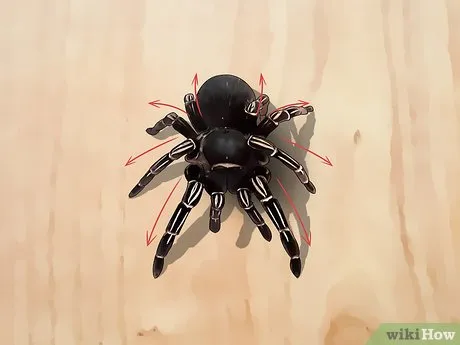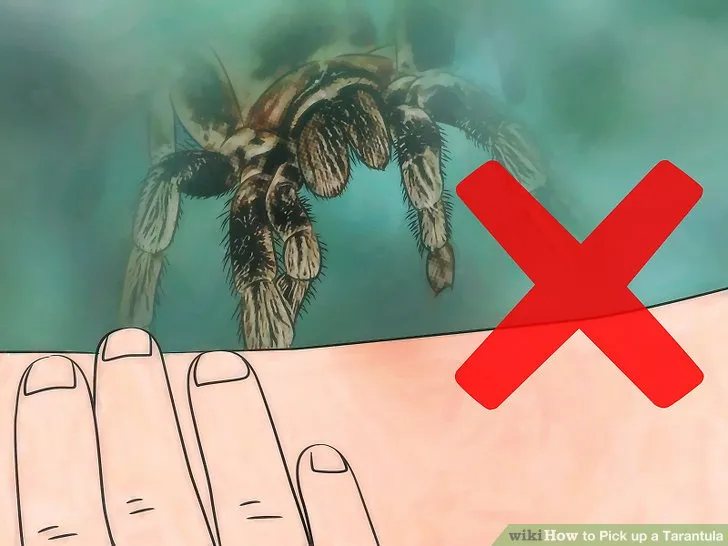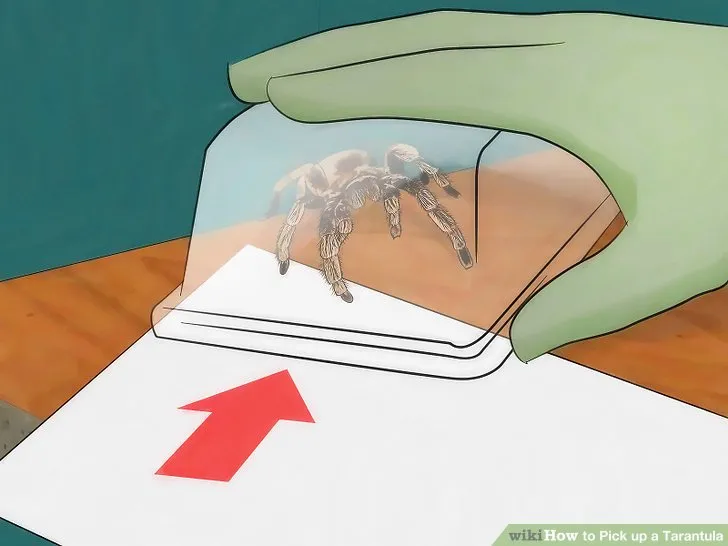Tarantula Handling Quick Guide [What You Need To Know]
Handling a tarantula can be a rewarding experience, allowing you to interact with your pet and observe its fascinating behavior. However, it’s crucial to prioritize the safety and well-being of both you and the tarantula. This quick guide provides essential information and step-by-step instructions to help you handle your tarantula safely and confidently. Remember, not all tarantulas enjoy being handled; therefore, it’s vital to respect their individual personalities and preferences. Always observe your tarantula’s behavior and be prepared to adjust your approach accordingly. This guide aims to provide you with the knowledge and confidence needed to handle your tarantula safely and ensure a positive experience for both of you. Careful handling is paramount, as tarantulas are delicate creatures and can be easily injured.
Understanding Tarantulas [Their Nature]
Before attempting to handle a tarantula, understanding its nature is paramount. Tarantulas are generally docile, but they are also defensive creatures. They may bite if they feel threatened. Bites are rarely life-threatening to humans, but they can be painful and cause localized reactions. Most tarantulas are nocturnal, spending the day in their burrows or hiding spots. They are sensitive to vibrations and changes in their environment. Knowing their natural behaviors helps you predict their reactions and handle them more safely. The way they react to stimuli, such as vibrations or sudden movements, is important to note. Some species are more prone to defensive behaviors than others; researching your specific tarantula species will give you a better understanding of what to expect. Providing a comfortable habitat and minimizing stress factors will increase the likelihood of a positive handling experience.
Tarantula Behavior [Decoding Signals]

Tarantulas communicate through subtle behaviors; learning to decode these signals is essential for safe handling. A tarantula that is relaxed and comfortable will typically exhibit calm behavior, moving slowly and deliberately. Observe for any signs of stress, such as raising their front legs, flicking hairs, or a defensive posture. These are clear warnings that the tarantula feels threatened and is likely to bite. Pay close attention to their body language. Defensive postures include rearing up, exposing fangs, or making a stridulating sound. These are clear indications that the tarantula is not in a handling mood. Recognize the signs early to avoid a negative encounter. Understanding these signals helps you anticipate their reactions and handle them with greater care and respect, improving the chances of a positive interaction. Always prioritize the tarantula’s well-being and avoid handling if it appears stressed.
Signs a Tarantula is Stressed
Recognizing stress signals is critical to avoid potential bites and ensure the tarantula’s well-being. Stressed tarantulas display several telltale signs; a defensive posture is the most obvious, where they raise their front legs and expose their fangs. Rapid movements or erratic behavior, like frantically trying to escape, are also indicators of stress. Flicking hairs from their abdomen (urticating hairs) is another defense mechanism; exposure to these hairs can cause skin irritation. A tarantula that repeatedly backs away from you or retreats to a corner is likely feeling threatened. Avoid handling a tarantula that exhibits any of these behaviors. Observing these signs is crucial for a safe and positive handling experience. If your tarantula shows signs of stress, it is best to leave it alone. Prioritizing the tarantula’s comfort and safety is of utmost importance.
Equipment Needed For Safe Handling
Having the right equipment is essential for safe and successful tarantula handling. A large, clear container is useful for transferring the tarantula if necessary. This container should have a secure lid to prevent escape. Soft, long tweezers can be helpful for gently guiding the tarantula. Always have a soft brush on hand to gently redirect the tarantula or brush away any urticating hairs. Protective gloves are recommended, particularly for beginners or when handling larger species. However, wearing gloves can reduce your ability to feel the tarantula’s movements, so use them cautiously. The right equipment helps minimize risks and ensures that you can safely interact with your pet. Careful preparation makes the handling experience safer and less stressful for the tarantula. Make sure all equipment is clean and ready before you start.
The Handling Process [Step-by-Step]

Start by ensuring the tarantula is calm and not displaying any signs of stress. Open the enclosure slowly to avoid startling the tarantula. Approach the tarantula gently, speaking softly to reassure it. Encourage the tarantula to walk onto your open hand, using a soft brush to gently guide it if necessary. Support the tarantula’s body by keeping your hand steady and close to the surface of the enclosure. Avoid sudden movements, which can frighten the tarantula. If the tarantula starts to move away, gently guide it back using the brush or your other hand. Once the tarantula is on your hand, move slowly and avoid dropping it. The key is patience and a gentle approach. By following these steps, you can minimize the risk and create a positive handling experience. Remember, the goal is to make the tarantula feel secure and comfortable.
Approaching Your Tarantula
Approach your tarantula with patience and a calm demeanor. Slowly open the enclosure, avoiding any sudden movements or loud noises. Observe the tarantula’s behavior; if it appears calm and relaxed, you can proceed. Speak softly to the tarantula to let it know you are there. Avoid any actions that could startle or threaten it. Gently place your open hand near the tarantula, allowing it to come to you. Be prepared to wait; the tarantula may take a few minutes to come out or may not want to be handled at all. Do not force the interaction. By approaching with patience and respect, you set the stage for a safe and positive handling experience. Taking your time and being mindful of the tarantula’s body language will significantly increase the chances of a successful interaction.
Encouraging Your Tarantula To Climb On
To encourage your tarantula to climb onto your hand, use a gentle and patient approach. Place your open hand near the tarantula, offering a stable surface. Do not try to grab or force the tarantula. Use a soft brush to gently nudge the tarantula toward your hand. Speak softly to reassure it. The tarantula may start exploring its surroundings. Be patient and allow the tarantula to move at its own pace. Never force the tarantula onto your hand; this can cause stress and make it more likely to bite. Encourage it by creating a non-threatening environment. Always make sure your hand is clean and free of any strong scents that might startle the tarantula. The more comfortable and secure the tarantula feels, the more likely it is to climb onto your hand. Observe the tarantula’s behavior and adjust your approach accordingly. If the tarantula isn’t interested, respect its decision and try again another time.
Proper Hand Placement [Technique]

Once the tarantula is on your hand, proper hand placement is crucial for its safety and your peace of mind. Keep your hand flat and steady, providing a large, stable surface for the tarantula to walk on. Support the tarantula’s entire body by keeping your hand close to the surface of the enclosure. This prevents it from falling. Avoid sudden movements or jerking your hand; this can startle the tarantula and cause it to fall or react defensively. Always be aware of where the tarantula is moving and adjust your hand accordingly. If the tarantula starts to move off your hand, gently guide it back with your other hand or a soft brush. Proper hand placement minimizes the risk of injury to the tarantula and reduces the chances of a bite. Remain calm and focused throughout the handling process. Handling a tarantula safely takes practice and patience, so don’t be discouraged if it doesn’t go perfectly the first time.
Handling Duration and Frequency
Limit the duration and frequency of handling sessions to minimize stress on the tarantula. Keep handling sessions short, generally no longer than a few minutes at a time. Observe the tarantula’s behavior and end the session if it shows any signs of stress, such as defensive postures or flicking hairs. Do not handle your tarantula every day. Space out handling sessions, allowing the tarantula to have plenty of time in its enclosure to feel secure and undisturbed. The frequency depends on the tarantula’s personality and your experience. Over-handling can lead to stress and potentially affect the tarantula’s health. It is more important to prioritize the tarantula’s well-being over frequent handling. Always monitor the tarantula’s behavior. A healthy, happy tarantula is the ultimate goal.
What To Do If Your Tarantula Falls
If your tarantula falls, act quickly and calmly. Avoid panicking, as sudden movements can worsen the situation. First, assess the situation; check the tarantula for any obvious injuries, such as damage to its abdomen or legs. If the fall was from a significant height, the tarantula might have suffered internal injuries. Immediately place the tarantula back in its enclosure. Provide a safe and comfortable environment, with plenty of hiding places. Monitor the tarantula closely for the next few days. Offer food and water but avoid handling. If you notice any unusual behavior, like loss of appetite or lethargy, consult a veterinarian or experienced tarantula keeper. Take extra precautions to prevent falls in the future. Ensure the enclosure is set up to minimize the risk. A tarantula falling is always a stressful event; acting quickly and correctly is essential to reduce harm.
Post-Handling Care for Your Tarantula

After handling, provide appropriate care to ensure the tarantula’s well-being. Return the tarantula to its enclosure gently, and allow it to settle back in. Ensure the enclosure conditions are ideal, including proper temperature, humidity, and substrate. Provide fresh water and food. Observe the tarantula for any signs of stress or injury. Allow the tarantula to rest and avoid any further disturbances for a while. Regularly monitor the tarantula’s eating habits and overall activity levels. By providing the right post-handling care, you can help your tarantula recover from the experience and maintain its health. This includes allowing it time to recuperate and ensuring its habitat is conducive to its needs.
Common Mistakes [And How To Avoid Them]
Several common mistakes can make handling tarantulas more challenging. Forcing the tarantula to be handled is a common mistake; it leads to stress and potential bites. Avoid making sudden movements; this will frighten the tarantula. Handling during molting periods is a mistake; molting tarantulas are extremely vulnerable. Over-handling is also a mistake; it stresses the tarantula. Not respecting the tarantula’s body language is another. To avoid these mistakes, always prioritize the tarantula’s well-being. Approach handling sessions with patience, gentleness, and a clear understanding of tarantula behavior. If you’re unsure about anything, it’s always better to err on the side of caution and skip the handling session.
Handling Safety Tips [Best Practices]
Prioritize safety at all times when handling a tarantula. Always wash your hands thoroughly before and after handling. Ensure your hands are free of any lotions, perfumes, or other substances that might be harmful to the tarantula. Handle the tarantula over a soft surface, such as a bed or a carpeted area, to minimize the risk of injury if it falls. Keep a close eye on the tarantula at all times during handling, and be prepared to react quickly if necessary. Never handle a tarantula while distracted. Have a first-aid kit on hand in case of a bite, though bites are rarely life-threatening. Research your specific species to understand its venom potency and temperament. Educate yourself on tarantula behavior and handling techniques. By following these tips, you can make handling a safe and enjoyable experience for both you and your pet.
